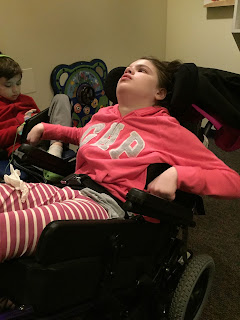First there is Mira. Mira's seizures have have always had an ebb and flow, their presence creating rough patches at home and at school, where she has multiple seizure days, mixed with days of dystonia. We have not made any medication or supplement changes other than adding a small dosage of zinc (refer to the Jonah update below) to her diet, which seemed to have a negative effect on her eating in the morning. After a few weeks of starting the zinc, she started refusing to eat anything in the morning - it became an enormous struggle just to get her to drink anything, even to take her actual medications. At a certain point, I think we realized it was probably the zinc that was affecting her appetite in the morning, for whatever reason, so we ended up reducing the dosage this past week. The reduction seemed to help her gain at least some of her appetite back - the entire time she was eating fine at school and we never heard of the frustration or struggles we were experiencing at home, especially in the morning. Hopefully, we have found a balance now. The effort is just to try and keep her comfortable and entertained, through walks, her toy, and activities at school. That in itself is physically and emotionally draining.
Then, there is Jonah, who has been a tornado the past few weeks. With school starting back up and lots of changes for 3rd grade, he has been struggling with separation anxiety, increased stimming, and overall increased ASD behavior. I made the mistake of starting him on a zinc supplement also, which after extensive research - see below) I thought was a good idea. This all backfired the first week, where Jonah was sent home (or stayed home) from school twice in 5 days, for vomiting. The first time he threw up was in the back seat of the car, where we pulling into the parking lot for drop off. I thought this was just an isolated case of the notorious and all too familiar 'welcome back to school stomach virus' we have been through many times before, but when the same scenario repeated itself three days later in the nurse's office, I feared my zinc supplement was most likely the culprit. Needless to say, we stopped the supplement and the ASD behavior continues, in full form, not that he was on the zinc long enough to see any positive results to begin with. Sarah had to go back to the hospital for the day to stay with her mom, which in turn disrupted Jonah's 'schedule' or whatever expectation he had for how the day was going to unfold, as he erupted into a 30-minute tirade of screaming, yelling, kicking the door, and repetitive, exhausting gesturing and finger-pointing at the driveway for her to immediate return. When he regresses into this intensely focused, erratic behavior, everything goes out the window - there is no response that will alter his state of mind. There is no redirection - he is completely fixated on what he wants. There is no rationalization. There is no logic. Welcome to autism.
And finally, there is Eli, who has been a saint for the last month. He has had his hormonal ups and downs, but overall, he has been going with the flow, taking his brother and sister in stride, and the nuances of our family dynamic, as best he can. I know that living with two siblings has affected him in more ways than we can count and all I can do is hope, that at the end of each day, he doesn't feel resentment. He has been robbed of so many things - a 'normal' relationship with his sister and brother, a simple outing to dinner as a family that doesn't end with someone in tears, or for that matter, the idea of a family vacation. Ironically, the reason for researching zinc so much over the past few months, was because of Eli. He is 14 and his skin is erupting with acne, as my skin did when I was his age. I desperately do not want him to go through the frustrations and anxiety I suffered in dealing with terrible acne in high school. Thus, I began to research treatment options, while getting him into see a dermatologist. He began taking a zinc supplement and has been doing great with it - no issues whatsoever. He is also taking doxycycline, as prescribed by his dermatologist. Hopefully it will improve his skin.
For whatever it is worth, here are some of the zinc links:
https://www.hindawi.com/journals/np/2015/972791/
https://www.ncbi.nlm.nih.gov/pmc/articles/PMC4386645/
https://www.ncbi.nlm.nih.gov/pmc/articles/PMC3757551/
https://www.ncbi.nlm.nih.gov/pmc/articles/PMC4363167/
http://onlinelibrary.wiley.com/doi/10.1111/jnc.12489/pdf
https://www.ncbi.nlm.nih.gov/pmc/articles/PMC2075129/
http://journal.frontiersin.org/article/10.3389/fnagi.2013.00033/full
I tend to research a topic heavily before ever trying a supplement and with the few that I have tried over the past couple of years, and after all of this research and reading, none have had a positive impact on anything, with the exception of pyridoxine with Mira. For years, it has been impossible to even get Jonah to try to swallow a vitamin (besides a chewable gummy multivitamin), so when he finally agreed to try and take one a month ago, it completely backfired and made him nauseous.
It makes me lose all hope that anything will help lessen the pain of epilepsy and/or autism. There is no magic bullet. There is seemingly, no answer.
























